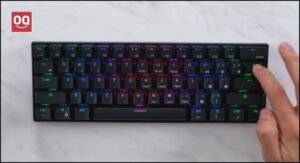In today’s digital age, the keyboard is our primary means of interfacing with computers, making it an essential component for productivity, gaming, and everyday computer use. With an extensive range of keyboard types and features to choose from, finding the ideal keyboard tailored to your specific needs can be a daunting task. From mechanical to membrane keyboards, ergonomic designs, key types, and connectivity options, navigating the world of keyboards can be overwhelming.
This comprehensive guide aims to ease this selection process and empower TechnoQia’s readers to make well-informed decisions by providing in-depth knowledge on various keyboard types, features, and key factors to consider when selecting the perfect keyboard. Our detailed and informative content will help you weigh the pros and cons of different options, ensuring that you choose a keyboard that is not only well-suited for your needs but also provides the level of comfort, efficiency, and user satisfaction that you desire.
In addition to offering educational and informative content, this guide will also feature Amazon Affiliate deals on top-rated keyboards, granting readers access to diverse options at competitive prices. With our expert recommendations and thorough analysis of specifications and features, selecting the right keyboard for your specific requirements will be a breeze.
Embark on this journey through the intricate world of keyboards and discover how understanding their unique features and characteristics can lead to selecting the perfect keyboard for your needs. Through TechnoQia’s expert guidance and rich insights, you will become highly equipped to confidently invest in the ideal keyboard, enhancing your productivity, gaming experience, and overall satisfaction.
Mechanical vs. Membrane Keyboards: The Battle of the Key Technology
To begin your search for the perfect keyboard, understanding the difference between mechanical and membrane keyboards is crucial. Each has its distinct features, advantages, and disadvantages, which cater to different user preferences and requirements.
- Mechanical Keyboards: These keyboards use individual, spring-loaded mechanical switches beneath each key. Mechanical keyboards offer a more precise and tactile typing experience, as well as faster response times and longer lifespans compared to membrane keyboards. They’re ideal for gaming, typing, and professional use, but tend to be louder and more expensive.
- Membrane Keyboards: Membrane keyboards utilize a rubber or silicone layer beneath the keys to register keypresses. They are generally quieter, more affordable, and thinner compared to mechanical keyboards but can be less precise and offer less tactile feedback. Membrane keyboards may be suitable for casual users or those on a budget.
When choosing between mechanical and membrane keyboards, consider your typing preferences, budget, and intended use, before making a decision.
Ergonomics and Form Factors: Ensuring Comfort and Efficiency for the Long Haul
Ergonomic considerations and various form factors play a vital role in selecting a keyboard tailored to your comfort and efficiency. Here’s what to look for when evaluating ergonomic keyboard designs, form factors, and layouts:
- Split Keyboards: These keyboards are divided into two separate parts, allowing your hands to maintain a natural and comfortable position while typing. Split keyboards can reduce strain on your wrists and hands, which is ideal for those concerned about ergonomics.
- Tenkeyless (TKL) and Compact Keyboards: The absence of a numeric keypad in Tenkeyless keyboards results in a smaller footprint, freeing up desk space and promoting a more central placement of your mouse. Compact keyboards take up even less space by reducing or combining non-essential keys, which can be useful for portable use or those with limited desk space.
- Adjustable Angle and Wrist Rests: Keyboards with adjustable angles and built-in wrist rests can further promote comfort and proper typing ergonomics.
Choose a keyboard with an ergonomic design, form factor, and layout that suits your personal preferences and specific needs to ensure long-term comfort and well-being.
Linear, Tactile, and Clicky Keys: Define Your Perfect Typing Experience
One factor that sets mechanical keyboards apart is the variety of key switches available, each providing different tactile feedback and typing experiences. The main types of key switches are linear, tactile, and clicky:
- Linear Keys: These switches are characterized by a smooth, consistent keystroke without any tactile bump or audible click. Linear keys are ideal for gamers, as they require less force to actuate, promoting faster keypresses.
- Tactile Keys: Tactile switches include a noticeable mid-travel bump that provides feedback when a keypress is registered. This tactile response can lead to improved typing accuracy and a satisfying experience, making them well-suited for typists and programmers.
- Clicky Keys: Clicky switches are similar to tactile switches but include an audible click sound when a keypress is registered. The clicky feedback is satisfying for some users but can be noisy, making them less suitable for shared or quiet environments.
Choose a key switch type that aligns with your preferences, desired typing experience, and intended use cases.
Wired vs. Wireless: Bracing for the Age-Old Connectivity Debate
When selecting a keyboard, you will also need to consider the pros and cons of wired and wireless connectivity options:
- Wired Keyboards: These keyboards connect directly to your computer using a USB or PS/2 cable. They offer a stable, latency-free connection, making them ideal for gamers and users who value performance and reliability. However, they contribute to cable clutter and may limit your range of motion.
- Wireless Keyboards: Wireless keyboards connect via Bluetooth or a USB receiver, eliminating cable clutter and providing greater flexibility in terms of positioning. They can be a great fit for home theater setups or users who value tidiness on their desk. On the flip side, wireless keyboards rely on batteries and may have a minor lag compared to their wired counterparts.
Determine which mode of connectivity best addresses your needs, taking performance, convenience, and aesthetics into account.
Discover Your Perfect Keyboard and Elevate Your Computing Experience
Equipped with the knowledge of key components, types, and features, you are now well-prepared to navigate the world of keyboards and confidently select the perfect one for your needs. By understanding the nuances between mechanical and membrane keyboards, ergonomic designs, key types, and connectivity options, you can now make an informed decision tailored to your specific requirements and preferences.
TechnoQia’s comprehensive guide provides all the essential information and expert recommendations that you need to enhance your productivity, gaming experience, and overall satisfaction using your computer. Combined with the rich choice of Amazon Affiliate deals, the best keyboard for your work, gaming, and everyday use is just a few clicks away. Invest in the perfect keyboard and enjoy the benefits of an elevated computing experience for years to come.





